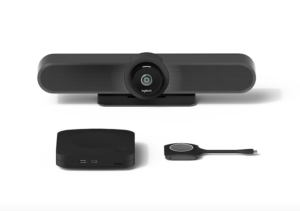The COVID-19 pandemic may permanently change the way we gather and communicate through a process I now refer to as Zoomification. Any scenario where each of us sits in front of a computer or other device will probably continue along much the same way, with cloud providers like Zoom, Google, Microsoft, and others making incremental changes to their software platforms to further simplify the way we interact with each other.
What about scenarios where groups of people need to gather together around the same camera? Anyone who has huddled around a laptop knows the pain of trying to take a one-to-one technology design and adapt it to a group (many-to-one) setting.
Related: Crestron Offers Multiple Options for Home Conferencing Technology
We’ve decided to focus on this Zoomification phenomenon at my integration business, Livewire, by helping people work and play better in their living rooms, home offices, classrooms, and conference rooms. We’ve divided up our focus into three key areas where we see immediate needs: Remote Learning, Take Me to Church, the Family Zoom Call.
Zoomification Scenario 1: Remote Learning
Most schools are providing either fully virtual or hybrid of virtual and in-person education this Fall, which means that parents and teachers alike are grappling with how to best facilitate online learning.
For parents, it’s all about making sure the home network is solid with no dead spots and that their children have a decent device, whether it’s a laptop or tablet.
Teachers are focused on mastering the many tools available for online learning and dealing with managing their students remotely (especially behavior issues and younger children). We all had a small dose of remote learning last Spring when there was a bit of a honeymoon period. If things didn’t work, no big deal, it was the first time any of us had dealt with a pandemic. In our current school year there’s now an expectation that parents will be able to manage their children, and teachers will have figured out how to deliver great coursework remotely.
For those learning scenarios that stay one-to-one, existing laptops and tablets seem to be “good enough,” as long as the network is stable. What about those schools doing both in-person and remote learning? Some schools are opting to take their virtual students and group them together into virtual classrooms, while others are attempting to have hybrid classrooms with in-person and remote learning take place simultaneously. These “many-to-one” scenarios are where high-quality audio and video conferencing solutions become a necessity.
We’ve taken a hard look at the various solutions out there enabling remote learning and decided to pursue a model supporting Bring Your Own Meeting (BYOM). This means the classrooms can run on Zoom, Teams, Google Meet, or any other meeting platform and the hardware becomes agnostic.

We’ve seen Logitech and Barco team up to bring their solutions out in simple “small, medium, large” configurations, where cameras and microphones are sized to the room. We’ve wrapped simple package pricing around them and pushed it out into our market to let our customers know we’re being proactive. These solutions are easy to install, configure, and support, so we’re optimistic that any K-12 programs deciding to transform their classrooms can easily test them to see if they make sense for the teachers, students, and parents.
Zoomification Scenario 2: Take Me to Church
Every Sunday close to 40 percent of Americans attend a religious service of some sort, and most churches have been closed down since mid-March. Churches are rethinking the way they deliver worship services moving forward. We’re starting to see more attention paid to the quality of worship audio/video production as it’s become more apparent that we may be home for longer than we thought (as well as churches realizing they can add more congregants with compelling virtual offerings).
Most Sunday church services are in one-way communication mode right now, often held in a webinar format where it’s tough to communicate back and forth with other attendees. By Zoomifying both house of worship spaces and family rooms, we’re paving the way for congregations to foster a sense of community virtually. The same Logitech/Barco solutions we’re offering to the K-12 community work just as well at home thanks to solutions like Leon’s Interactive FIT speaker bar solutions, which house webcams and speakers together in a very clean interface.
Larger house of worship spaces with older broadcast capabilities have been using the pandemic downtime to upgrade their sanctuaries and pulpits to better enable their in-house volunteers or AV staff to offer up higher quality streaming. Remote worshippers want to take advantage of these high-quality feeds and most are currently stuck with using AirPlay or Chromecast, which tends to render horrible audio/video delay and lip-syncing issues when viewed on a typical family room surround sound setup.
Zoomification Scenario 3: The Family Call
One of my friends shared that we’ve been doing things during the pandemic we could’ve been doing all along. One of these “could’ve been doing all along” traditions in many households is a weekly check in with loved ones via Zoom.
These comedic, sometimes awkward virtual gatherings lay bare our technical shortcomings for all to see. Mom’s on mute, Dad’s video doesn’t work, and kids are playing tech support. Forget trying to get the whole family together around a laptop. It doesn’t work! Thankfully solutions like Leon’s Interactive FIT, combined with Logitech/Barco videoconferencing, mean that the whole family can sit on the couch and hang out with each other while socializing with grandparents on the other side of the country.
As we continue coming to grips with the notion that we might be kept apart for longer than we originally thought, homeowners and businesses are more open to adapting their spaces to these many-to-one gathering Zoomification scenarios. I’m excited to see what the rest of 2020 brings because no matter what happens, some of us are never going back to the way things were and need to pivot into a “new normal.”









